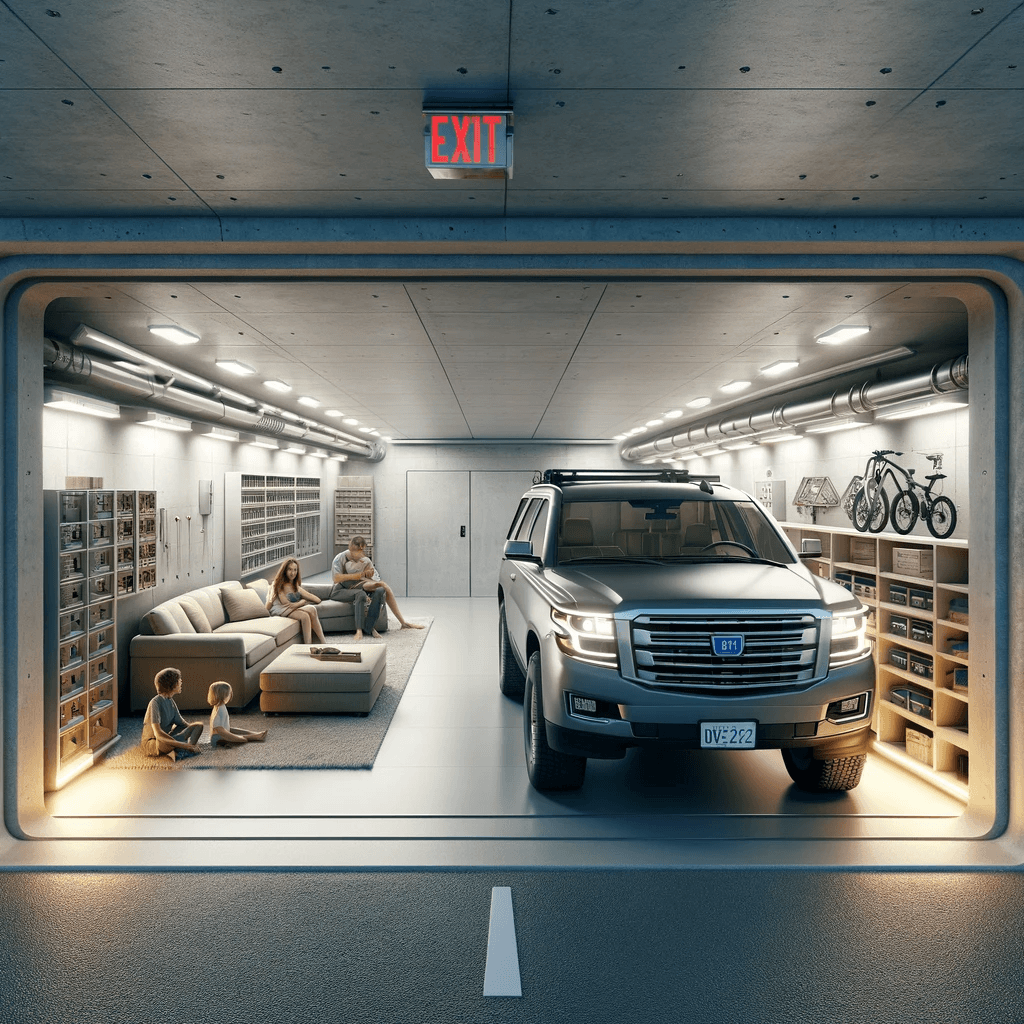Bomb shelters are a valuable asset during times of chaos. These underground bunkers protect people from bombs, treacherous weather and other dangerous events. During crises, people want to protect their belongings — so what about fitting a car inside a bomb shelter? Can the facility protect cars, trucks and SUVs? Bunkers with the proper features can shield these vehicles from outside vehicles. This guide details how bomb shelters keep vehicles safe.
Can a Bomb Shelter Keep Vehicles Safe?
Yes, bomb shelters can keep vehicles safe. These above-ground or underground facilities have incredible strength to withstand bombs, nuclear attacks and other deadly events. Their durability protects cars, too — as long as they fit inside the facility.
The most pertinent bunker features protecting cars include:
- Blast resistance: The primary objective of a bomb shelter is to protect internal components from blasts. An outside force could detonate lethal explosives like a nuclear bomb, so the facility must face these situations. Building shelters with reinforced construction significantly helps the cause.
- Secured walls: Bombs and storms are obvious threats, but bunker owners must be aware of human dangers. People outside and inside the bomb shelter could infiltrate the facility and damage vehicles, so having security cameras is essential. Modern bunkers typically have security cameras lining the perimeter to give shelter administrators peace of mind.
- Security cameras: Bombs and storms are obvious threats, but bunker owners must be aware of human threats. People outside and inside the bomb shelter could infiltrate the facility and damage vehicles, so having security cameras is essential. Modern bunkers typically have security cameras lining the perimeter to give shelter administrators peace of mind.
- Generators: Power is vital inside a bunker and might not always be available. Bomb shelters require generators to keep the lights on and to help vehicles inside. Some bunker owners may have electric vehicles (EVs) requiring daily or weekly charges. EVs typically need 7.2 kilowatts of electricity using a level 2 charger.
- Air Filtration: People and cars inside the bomb shelter need protection from harmful air, so many bunkers have nuclear, biological and chemical (NBC) air filters. These systems filter 99% of contaminants to make the air breathable inside.
What Bomb Shelters Fit Cars?
People considering building or acquiring a bomb shelter should consider which bunkers protect vehicles. Their investment now could pay dividends later during a lethal attack. These bomb shelters are large and strong enough to cover most vehicles.
Above-Ground Shelters
Some builders choose to put their bomb shelters above ground. These facilities are easier to spot from the sky, so the architects must emphasize structural integrity even more. Above-ground shelters typically have multiple layers of steel and concrete to maximize protection from the outside.
Constructing an above-ground shelter is easier for builders and bunker owners storing vehicles. They’ll need at least one entry and exit point for their cars leaving the facility. Architects must also ensure the bomb shelter is large enough to fit machines, like generators, inside the building or the designated garage.
Underground Shelters
Underground shelters often are better than above-ground bunkers because of their structural integrity and fallout protection. Strong blasts, radiation and even floodwaters have a harder time harming underground bunkers because of these advantages. Such features make underground shelters attractive for storing cars.
Another advantage of underground bunkers is their secrecy. These shelters are ideal for storing expensive sports cars or vehicles with advanced security features. Like above-ground shelters, underground shelters require enough size to fit the vehicles and entry and exit points. However, they’ll need increased ventilation because of their limited access to fresh air.
Luxury Shelters
Some people who want a bunker go all out to protect themselves, their family and their cars. They’ll purchase luxury bomb shelters with 22 beds, a gym, a storage room, a greenhouse, workshops and a garage. Luxury bunkers are excellent choices for those needing to stay in one place for extended stretches.
These luxury compounds are ideal for large families or multiple groups staying together because they can easily fit about five vehicles. Plus, there’s plenty of room for tools, workbenches and other stations for car maintenance. Luxury shelters are a significant financial investment but are worth every penny when disaster strikes.
What Do Vehicles Need Inside Bomb Shelters?
Getting the vehicle inside the shelter is only half the battle. Bunker owners must take precautions and ensure their cars are ready to use. These six components are necessary for protecting vehicles inside the compound.
Size
The bunker’s size is the first component owners must figure out. Any bomb shelter fitting a car must have designated spaces for the vehicles. Luxury bunkers have special sections for a garage, but others might not have this opportunity. The shelter could be a single large room, so the inhabitants must carve out an area large enough to store at least one vehicle.
Insulation
People need heating and cooling throughout the year to survive, as do your vehicles. Insulating a bomb shelter garage means cleaning walls, filling gaps and installing insulation throughout the facility between. By their nature, garage doors can allow outside air to enter into the building, so making sure the door properly closes and seals is key.
External motorcaves add an additional layer of protection between the inside of your shelter and the outside air while still allowing your vehicles to enter and exit safely if need be. Cars can suffer mechanical issues if exposed to extreme temperatures over a significant period of time, so insulating the facility is essential for remaining comfortable and operational. Concrete is often a popular choice for extra insulation because of its density and durability, maintaining a consistent range of temperature year-round.
Humidity Protection
Poor ventilation leads to uncomfortable conditions for the people and the cars inside. Discomfort can lead to unwanted outcomes for the vehicles, especially if the culprit is humidity. Moist air is one of the worst fears for vehicle owners because it causes problems throughout the vehicle.
First, humidity affects the paint job. Moisture causes paint to peel because the car traps moisture underneath. Water droplets can lead to mold and mildew growth if they’re on the vehicle for a long time. Moisture causes the most significant problems once it reaches the car’s metal parts. Over time, water will cause rust and damage the components. Without warning, the pieces could fail and endanger everyone inside the vehicle.
Bunker owners must protect their facility from humidity by installing dehumidifiers in the garage, repairing leaks and performing routine maintenance on their ventilation systems. They should also regularly inspect their vehicles for rust formations.
Air Filter
Storing vehicles inside the shelter requires strong air filters because of their tailpipe emissions. When the motor runs, cars emit dangerous gases that can travel throughout the bunker if the operators aren’t careful. Air filters, such as the NBC air filtration unit, are necessary for protecting all inhabitants.
Carbon Monoxide Detector
Running vehicles in enclosed spaces increases the risk of carbon monoxide (CO) poisoning. CO is tasteless, colorless and odorless, so there’s no way for people to detect it on their own. Cranking a car’s ignition emits CO and can be deadly in enclosed spaces. Bomb shelters with vehicles must have CO detectors to protect everybody inside.
A high CO concentration only needs five minutes to be lethal, emphasizing the importance of CO detectors. If CO doesn’t kill, it can cause discomfort and unwanted symptoms. Some signs of CO poisoning include headaches, weakness, chest pain and vomiting.
Stormwater Protection
During torrential storms, bringing vehicles inside for protection is essential. Strong winds, rain and tornadoes can destroy cars and damage other objects in the area. Cars are also vulnerable inside the bunker because of stormwater. Bomb shelters can have stormwater runoff and risk flooding and water pollution. Over time, the bunker and the vehicles risk erosion.
Fortunately, bunker owners have ways to mitigate stormwater runoff. For example, they can construct a collection system or use trees to capture rain. While concrete is helpful for protection, it could become a liability because it can’t absorb water. Bunker owners should consider pervious concrete if their area is prone to heavy rain.
Creating a Car Safe Haven
Bunkers primarily protect humans, but they can shield valuable belongings, too. While cars, trucks and SUVs are sizeable, extensive underground bunkers are large enough to store these machines comfortably and protect them from outside threats. When indoors, vehicles need protection from blasts, humidity and stormwater. Bunker owners must also protect the people inside from CO and other dangers.


